#that feel the need to passively reboot for social media points
Text
.
#the amount of people who have absolutely no connection to the I/P debate nor are educated about it#that feel the need to passively reboot for social media points#while being misinformed about the subject and only knowing one side of the story#ignoring the fact that 400 rockets were fired at Israel and many are dying#like I have to be fearful for my family#especially the one that study in Jerusalem#but since there are a total of 14m of us getting our voices heard at the same level as the other side is nearly impossible#so of course everyone is not informed of the horror and fear that we experience on a daily basis#like the amount of personal friends I want to unfollow or disengage with or just educate if I have the strength in me to get into#that conversation like 50 times#also I keep seeing h*locaust comparisons and that’s the most antisemetic bullshit I’ve seen in my life#like not only does it show how uneducated you are about what’s going on ther#it also shows that you don’t know shit about what happened in the h*locaust
6 notes
·
View notes
Text
Birth Story!
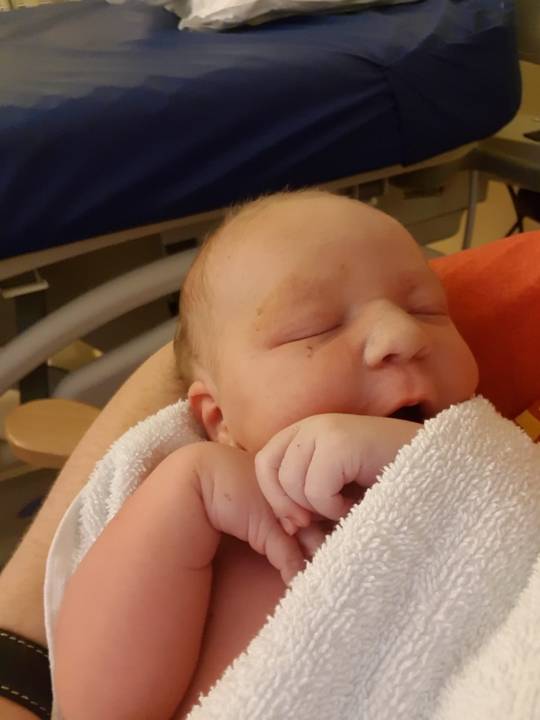
Finn about an hour after he made his entrance.
Someone that I know (let’s call her ‘Beth’) recently put up an Instagram about the birth of her son via C-Section. She posted this with best intentions of promoting April as Cesarean Awareness Month, but some of the content in her caption has inspired me to look further into C-section and natural birth and share my birth story. I’m hoping that what I write, I write without bias and I am aiming to give a full and well-educated picture of labour and birth.
From the word go, I knew that I wanted to give birth as naturally as possible, and I’m very fortunate that I was able to have Finn with only minimal intervention by the doctors and midwives that looked after me. For Beth, her baby was in breach and growing at too fast of a rate for her body, meaning she was put forward for an elective c-section. I think everyone that has been through it, can agree that birthing a child is painful no matter which way you do it. So it bothered me that Beth has written off how hard natural labour and birth can be as she testifies that a C-Section is the harder experience. Amongst other parts of her post, this seems really quite misguided; especially considering you really can’t comment on which is harder if you haven’t experienced both.
In 2017, 11.5% of UK mothers had planned C-sections. A planned C-Section is performed at 39 weeks. By performing the surgery at 39 weeks any risk for the baby’s health is majorly reduced as well as risks to the mother. For a elective c-section that mother generally has to have a medical condition (diabetes, high blood pressure or an infection that can be passed to the baby, such as HIV) or the baby poses difficulty in labour (the baby is in a breach position or if the mother is carrying twins). One of the perks with an elective c-section is that it’s, for the majority, predictable and calm compared to a natural birth.
Instead of turning up at the hospital on a chosen date and time, I made the call to my mum that “it was time” at 2:30am after not being able to get comfortable enough to sleep, and my contractions starting to ramp up. I had a sweep 6 days before I went into labour, at which point I was 3cm dilated. My midwife warned that when the baby decided it was time to come, it was probably going to be quick. 13.5 hours of labour says otherwise. A c-section takes out that time in labour, with the average c-section surgery taking just over an hour (15-20 minutes to deliver the baby and 45 minutes to stitch everything back up).
Another thing that Beth mentions in her post is that during a c-section, a woman's “organs are torn out and put back together like a jigsaw”. This is entirely inaccurate and scaremongering at its best. Though c-sections are considered major surgery, no organs are taken out of your stomach - honestly, they don’t flop your intestines out - the only parts of you that are affected are your abdomen and your uterus, both of which are cut open to give access to the baby. If any organs are touched by the surgeon, it’ll be your intestines and bladder, and it’ll only be to nudge them out of the way for a better view of the uterus.

Diagram of a C-section
Compared to a relatively short procedure, labour and natural birth is long and physically gruelling on your body. My mum cleverly explained labour to me as feeling “like toothache in your belly.” It goes from an uncomfortable throbbing to having you double bent in a pain that radiates throughout your body. I have a very high pain threshold - something labour definitely validated to everyone - but I dreaded the 2 hourly dilation checks by the midwives. PJ counted down the time to the next one as a form of encouragement to get me through it, but it didn’t make me look forward to them any more. It doesn’t hurt, let me just make that clear, but when your body is going through the throes of labour someone touching and prodding at you is the last thing you want.
Eventually, after about 11-12 hours I was told that I could push - I’d been wanting to push since I was 7cm about 3 hours earlier, but was told “to fight the urge” - after around 1.5-2 hours of moving into various positions and pushing for my life, my contractions completely died off due to exhaustion. The midwives had tried to feed me toast to give me energy several times, but I just threw it back up. At that point I was taken to a different area of the labour ward and hooked up to a drip of Pitocin to reboot my contractions. I remember asking the senior midwife how long it would take to kick in, I’d literally finished the question and went into very powerful contractions, which would eventually see Finn born.
Finn was born at 16:55pm on the 20th of August and was a “kiwi birth”. A kiwi birth is the medical term for a baby delivered via ventouse. A ventouse is a suction device that is attached to the top of your baby’s head; when you experience a contraction the obstetrician or midwife will gently pull on the device to help birth the baby. In order to get Finn out, I was also given a small procedure called an episiotomy. An episiotomy is the widening of your vagina; a small incision is made along your perineum in order to make delivery easier. If you have any intervention, such as ventouse or forceps, you’ll probably have this procedure. It does add to your postpartum recovery time and is really uncomfortable. I had to sit on pillows for about 2 weeks after Finn’s birth to help with the pain and soreness. The recovery time after a natural birth is substantially less than that of having a C-section; my episiotomy cut took just over a month to heal completely with an OCD level of personal hygiene downstairs to prevent any infection. Women that deliver via C-section, on average, spend twice as long in hospital and have a recovery time of at least 6 weeks. The placement of the post-surgery scar means that it is painful and your mobility is greatly reduced. Knowing how busy I was with Finn in the first month after his birth, I can imagine that this does make those first 6 weeks very difficult for mothers.
I experienced above average blood loss during birth, nothing too scary but it warranted taking iron tablets for the month afterwards. I was lucky that I was looked after by a team of excellent doctors and midwives that stopped the situation getting out of control and potentially causing unnecessary trauma to me, both physically and mentally. Some of the not so lucky women can develop a condition called Tokophobia, which is overwhelming anxiety associated with a traumatic previous birth and often leads to mothers choosing elective C-sections for subsequent children.
I could go into the the risk that vaginal birth can potentially have with vaginal tearing and stretching, however your midwives monitor this throughout you labour and will intervene if you are at risk of either of these.
Another associated problem with C-sections is that they make breastfeeding harder after delivery. I know that this is something that Beth struggled with. However, so did I; and out of the two of us, Beth is the only one that was able to continue breastfeeding her son for any length of time. I had to stop after 2 weeks with Finn as my milk production was far too low for what he needed, and I put this, in part, down to the fact that my body was trying to recover from the trauma of his birth. It was healing that bits that needed healing and shutting off the bits that it didn’t see as entirely necessary at that point. This means that Finn has been formula fed for essentially all of his life so far, but that’s another story for another time.
And so concludes my birth story, and passive-aggressive rant at Beth. All I will say is that childbirth takes it toll on your body, regardless of how you deliver. The whole “one way is harder than the other” school of thought needs to stop. It can create unnecessary pressure, fear and guilt for expectant mothers, which really isn’t where their focus needs to be. As long as mum and baby are healthy and thriving at the end of their birthing journey, that is all that matters.
If you do have any worries or concerns about any element of pregnancy, labour or birth, speak with your midwife. She’ll be able to offer some advice or signpost to someone that can help.
—
Follow Me on Social Media:
Instagram: Elz_Andi
Twitter: @Andi_Elz
Goodreads: https://www.goodreads.com/user/show/9350421-ellie
#birth story#mum blogger#mum blog#labour#birth#parenthood#medical#expectantmother#pregnancy#pregnant#baby#pregnancyadvice#pregnancysupport#csection#naturalbirth
1 note
·
View note
Text
Wonder Woman #50 postmortem: “You know how strident Wonder Woman fans can be”
I want to cap off my readthrough of this unmitigated shitshow with a look at a recent interview James Robinson did with Newsarama, reflecting back on his twenty-issue Wonder Woman run.
I’m doing this for two reasons: One, because having read the full run and formed my own impressions (and, dare I say, some rather strident opinions), I genuinely do think it can be interesting to see what the writer has to say about it, what they were trying to achieve with it and, looking back, how they feel about the run.
And two, because having read what Robinson has to say, HOOBOY, I HAVE A FEW THOUGHTS OF MY OWN.
Newsarama: James, the one through-line of your entire run is Wonder Woman's twin brother, Jason. I know he was the motivation for you working on this book. Did you know the whole story before you started? Or did this story evolve as you wrote it?
James Robinson: I knew to a degree. As you said, I was specifically asked to pay off the gigantic plot point that Geoff Johns had left at the end of "Darkseid War." So it was always part of my plan.
Are. You. FUCKING. KIDDING ME.
The entire premise of this run. The wholesale derailment of Wondy’s Rebirth story. The rampant shredding of her newly-established Rebirth backstory. Sidelining Diana for the better part of a year in favour of a repulsive twin brother and some shit with Darkseid.
ALL OF THAT.
Served no wider purpose.
Was not intended to build towards some Rebirth metaplot or contribute to an overarching Justice League story.
Was mandated, in fact, for no other reason than that Geoff motherfucking Johns wanted to TIE UP A DANGLING PLOT THREAD FROM TWO-YEAR-OLD CROSSOVER.

He goes on.
Originally, I was going to be on it for a shorter period of time. I had originally planned to be on it for about eight issues, I think. And then when I was getting the twice-monthly book in on time (which is tough; they really beat you up), they asked me to stay on.
There are better, more eloquent arguments against the fortnightly publishing schedule — which is incredibly punishing for creators and prioritises quantity ahead of quality — but none, perhaps, are more simple or succinct than James Robinson got to write twenty issues of Wonder Woman because he got his scripts in on time.
And that gave me more time to develop Jason and play with him more.
I was careful to make sure it wasn't only about Jason, however. I was already getting crap from social media about how this is Wonder Woman's book and she should be the center of attention at all time. You know how strident Wonder Woman fans can be.
Well, that’s an interesting and thoroughly disingenuous interpretation of the critique.
The criticism was not that Wondy must be “the centre of attention at all times”, and therefore Robinson was wrong to spend any time developing any character other than her.
It was that Robinson turned Diana into such a passive, reactive — and, frankly, incompetent — character that she became barely necessary to the story at all. You could remove her from most of the issues in the Darkseid arc without affecting the progression of the plot at all, because she never does anything.
Yes, I got irate when Diana would routinely show up in six or seven pages of an issue, if she appeared at all. Funny thing, when I pick up a book titled Wonder Woman, I expect to occasionally see some actual WONDER WOMAN.
But that was the symptom rather than the problem. Because even when Diana was on the page, she was absent from the story.
And part of this is also about the characters Robinson chose to focus on instead of Wondy: Jason, Grail and Darkseid. Three characters that a lot of fans weren’t interested in, didn’t like and frankly resented having shoehorned into Wondy’s story. True, Robinson may have been asked to include them in the story, but it was his choice to prioritise them over Diana, and it was his writing that shaped Jason into such an odious character (something he confirms in the interview: Johns came up with the idea, he says, but “Most of who the character is now is stuff that I've actually come up with.”)
Put it this way: I didn’t see anybody complaining in December 2016 when Greg Rucka devoted an entire issue to Barbara Minerva’s backstory, did you?
But oh, I’m sorry, was that too strident for you?

Nrama: During your run, you tied into several events that were going on elsewhere in the DC Universe. Even this current story arc ties into Dark Nights: Metal and involves the Justice League. Was that a goal, to make Jason part of the greater DCU?
Robinson: Yes. I always do that stuff, though. I always try to tie into bigger stories. Whether it was my stuff at DC or what I did at Marvel, like Fantastic Four and Invaders and what-not, I always enjoy that about comic book universes. I like when writers try to embrace the whole place.
Here’s the thing about this.
I like the sandbox nature of a shared universe. I’m not a fan of event tie-ins, which have a tendency to derail the stories of individual books in order to aggressively market some company-wide crossover that I couldn’t care less about, but I like that there’s this whole wider world of heroes and villains and settings and mythologies that writers can draw on and play with. And you can tell some really cool stories out of the collision of those different mythologies and characters — think Phil Jimenez’s ‘Gods of Gotham’, for instance, where the Wonderfam and the Batfam are forced to team up when some of Batman’s most powerful rogues are possessed by Ares’ children.
That’s not the way Robinson loops the wider DCU into his stories, or at least it wasn’t in Wonder Woman.
Robinson goes for insider references, often obscure ones, of the sort that will only make sense to people who’ve been reading the same comics as him over the past three decades.
In WW #33, he introduced and then immediately killed off a rebooted version of the Atomic Knights in a four-page sequence that added nothing to the plot.
In WW #42, he featured a flashback to Jason fighting the Deep Six, a group of Jack Kirby villains. Ostensibly this is framed as a set-up by Grail to orchestrate her first meeting with Jason, but Robinson milks it to crack jokes about Kirby’s 1970s dialogue — and if you’re not familiar with the characters (as I wasn’t), their inclusion makes little sense.
In the same issue, Robinson also works in the Wild Huntsman… apparently for no other reason than to amuse himself… and again, if you don’t know who he is, you’ll have no idea why Grail is trying so hard to kill him or why you should care.
And then there’s the Metal tie-in.
Like I said, I don’t like event tie-ins, but it is possible to make them work. G. Willow Wilson’s Ms Marvel has been looped into a number of crossover events over the course of its life, and while I’d prefer that clusterfucks like Civil War II stayed the hell away from Kamala and her pals, Wilson has done an effective job of using these events as a springboard for some really interesting personal conflicts and character work. There’s no extra required reading for these stories; she gives you everything you need to know, so those who aren’t following the event aren’t at a disadvantage.
Robinson gives you nothing.
This is how he links the Dark Gods’ story into Metal:
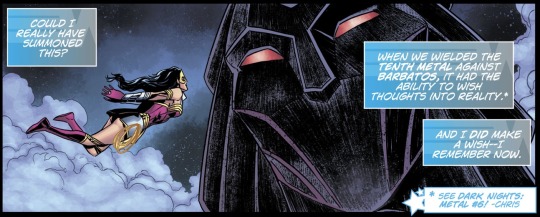
Diana [narration]: Could I really have summoned this? When we wielded the Tenth Metal against Barbatos, it had the ability to wish thoughts into reality.*
Ed. note: * See Dark Nights: Metal #6! — Chris
And a couple of pages later —

Karnell [narration]: ...our beautiful world — which you regard as the ‘Dark Multiverse’ — we see as a paradise… where we were more than even gods to our worshippers… we were everything!
I didn’t read Metal and I’m not planning to. That’s not a value judgement, it’s just not something that sparks my interest.
But it means I don’t know who the bloody hell Barbatos is, and I’ve never heard of the Tenth Metal. I don’t know what the Dark Multiverse is, or how it works, or how it differs from the regular multiverse. When Robinson says Diana made an inadvertent wish while she was wielding this Tenth Metal, I don’t know if he’s picking up on a story point in Metal that I need to read up on.
So right off the bat, Robinson has alienated anybody who isn’t familiar with the event comic he’s drawing from.
And what infuriates me is that at the same time as he was doing all this, Robinson was getting muddled by Wonder Woman’s continuity, conflating superseded New 52 canon with (contradictory) Rebirth canon, inadvertently retconning things and failing even to keep his own narrative consistent. I’d argue he needed to spend less time making references to other comics and more time making sure he understood the one he was writing.
Robinson: [...] what I've always loved about Wonder Woman is her strength. Even when she was in that phase in the white costume, where she didn't have her powers, she had great strength.
Oh, you mean this era?

The era where Diana lost not only her powers, but all of her training and skills? Where she became a weepy, insecure romantic heroine, reliant on men to guide and save her from her own inexperience and her uncontrollable female emotionality? The era where she was constantly crying over her latest rugged love interests? That awesome era?
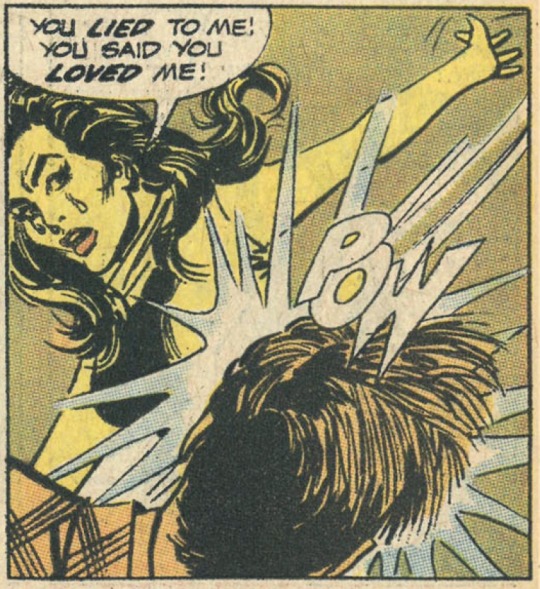
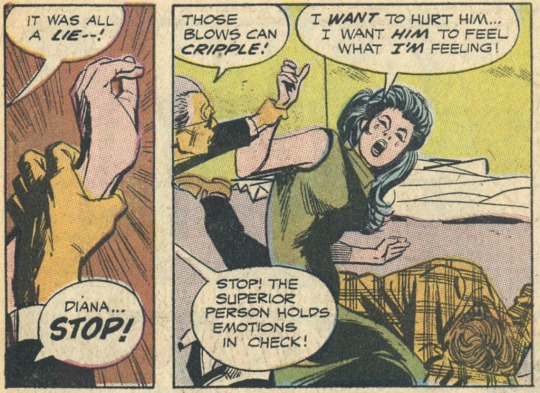
(Also misogynistic, racist and homophobic as fuuuuuck, but that’s another discussion.)
One of the reasons that era ended was because Gloria Steinham [sic] said, "Hey, she's Wonder Woman! She's a superhero and you've taken away her powers!"
But I actually thought her lacking powers was like saying, I don't need them to be a strong woman. And I think that was almost a more powerful message. I was surprised Ms. Steinem didn't get that, to be quite honest with you.

This is a characterisation of Steinem’s role in that period of Wondy’s history that I’ve seen before (always from men in the comics field), and it’s never sit well with me. It carries an unpleasant shade of gatekeeping.
The implication is that Steinem’s feelings about Wonder Woman (a character had loved since childhood) were less valid or even flat-out incorrect because she hadn’t read the right comics, that she was an ignorant outsider who ruined a good thing by coming in with a political agenda and trying to make Wonder Woman about feminism, that she didn’t have a right to complain about the comic because she wasn’t a ‘real’ fan.
And what Robinson doesn’t mention, as critics of Steinem and Ms. Magazine’s lobbying for a return to the classic Wondy rarely do, is that this campaign was set against a backdrop of unimpressive sales numbers and a struggle over the new direction that eventually gave rise to an ambitious and quite likely divisive ‘women’s lib’ arc written by African-American sci-fi writer Samuel R. Delany, which was intended to culminate in Diana triumphing over a group of male thugs attempting to shut down an abortion clinic run by women surgeons.
I have no doubt that Steinem played an important role in the way events panned out, but I’m also not surprised the ‘women’s lib’ arc never made it past its first issue.
(It was a truly dreadful first issue, btw, though the whole story behind it and what Delany was trying to do with it is fascinating.)
But that didn’t stop DC from kicking off Wondy’s superpowered return with the murder of a composite character representing Steinem and female DC editor Dorothy Woolfolk (whose name had previously been floated as editor for the book).
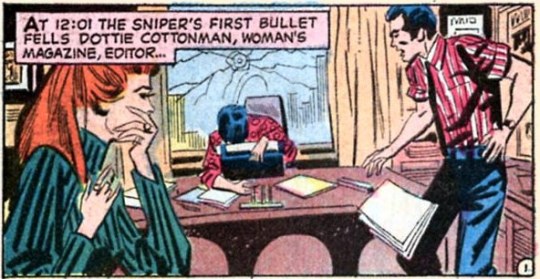
Then as now, Steinem got blamed by the gatekeepers for daring to interfere with Wonder Woman.
Nrama: Do you think Jason picked up some of her strength over the course of his story arc during your run?
Robinson: I think so, at least at the beginning as he was starting to develop. Now, technically, I suppose he's more powerful than her in that he has the power of their father Zeus and the power of storms and air control and things like that.
I like the fact that when he's given this armor, he realizes that his sister should have gotten it.
And he knows that the powers he has do not make him the better hero.
He knows his sister is the better hero.
So by the end of it, he just wants to be worthy of her, which I think was a nice character arc for him.
I can see how Robinson tried to achieve this character arc, but I wouldn’t call it anything close to a success.
Jason started as a deeply, deeply unlikeable character. He’s deeply selfish and emotionally immature. He doesn’t think about the consequences of his actions, mostly because he’s only ever concerned about how things affect him. When he learns about the mother he never met, when his adoptive father vanishes, every time Hercules leaves on one of his journeys, as he follows his twin sister’s heroics through the media — his thoughts are never about them and what they’re doing, or how they’re feeling, or if they’re okay. It’s always about how they’ve failed him, wronged him, abandoned him.
When we first meet him, he is helping goddamn Darkseid to systematically murder his own siblings. And it’s not because he’s being mind-controlled, or elaborately manipulated into believing that Darkseid is the good guy. It’s because he hates the guts out of Diana, the sister he’s never met, because he believes he’s entitled to the life that she has, and he wants to kill her for it.
If you want to get your readers past all that, you need one hell of a redemptive arc, and that’s one thing Jason never gets.
Because what happens next, after Jason gets an attack of conscience and switches sides, is that he freeloads off Diana, trashes her house, guilt trips her when she tries to set boundaries, and then when, heroism and glory don’t immediately come easily to him, runs away from home in the middle of the night.
The next time we see him is when he returns with the armour and a personality change. He’s still inexperienced, brash, impulsive and annoying, but that’s more or less the extent of it — he’s no longer the thoroughly objectionable character we saw in his first seven issues, and there’s no real explanation for the change.
Really, the vast majority of Jason’s character development takes place in the space between his disappearing at the end of WW #40 and reappearing at the end of WW #41.
Nrama: Wonder Woman #50 definitely feels like it's an ending to your time on Jason's character, and even his time in the book.
Robinson: It definitely has an element of finality to it, but Jason can be there for other writers, or indeed me, if I ever got to write him again.
Excuse me? If you ever got to what now?
Nrama: Is that a hint?

Robinson: I do enjoy writing him. I have this vague fantasy of one day doing a story and calling the comic Jason's Quest, which is an old DC title.

But no one's asked me so far and probably won't. So it's just something in my mind right now.
please, dear god in heaven, please let it stay there.
27 notes
·
View notes
Text
Want to Win at Social Media? Here's What Followers Want, According to Experts at SXSW
People have a lot of feelings about social media.
Love it. Hate it. Use it for business. Build a brand on it. Quit it. Come back to it.
With so many mixed messages, how are marketers supposed to stay on top of the right way to use social media -- and moreover, what users actually want from it?
To answer that question, a panel of social media experts -- Teen Vogue's Rajni Lucienne Jacques, Facebook's Tutti Taygerly, and Instagram's Joshua Dickens -- shared their insights on what followers want the most in today's climate, in a discussion moderated by Work & Co's Gene Liebel.
What Followers Want
1. Communities
Think back, if you can, to a time when the folks who managed a brand's Facebook page were known as "community managers." That's because we once lived in an era when, not even that long ago, that was the purpose of pages like these.
And while there are still Groups available on Facebook -- smaller, often private destinations designed for communication among smaller groups of people -- it can be argued that they've lost a bit of their luster and are not the first destination for brands looking to build audience engagement.
But within the current global climate, the panelists appeared to agree that users are drifting back toward the idea of using social media to build a community: to give voices to a cause, to connect with others who care about the same issues they do, and to create a movement around it.
In fact, said Jacques, "Social media is the one thing that galvanizes a movement. [It] allows people to gather in a way that is faster and more efficient."
And while galvanizing a movement might not exist within the strategic models of goals for a small-to-midsize, business-to-business organization, there are still ways to leverage your social media presence to build on the idea of a community.
Take, for example, something that was said by WP Engine CEO Heather Brunner at an earlier SXSW panel: Businesses need to ask themselves, "What’s right for your employees? What’s right for your customers?"
Once those questions are answered, marketers can determine the issues around which the brands they represent can build communities.
If nothing else, brands can provide a venue for connection, which Taygerly said she believes social media users still want.
"As a company, we’re not just trying to promote passive consumption of content," she explained. "We’re trying to pay a lot of attention to that."
That actually aligns with certain ranking factors resulting from the changes Facebook made to its algorithm earlier this year. While people's News Feeds display less branded content overall, it does prioritize Page posts with more authentic engagement within the comments section (as opposed to such "share-bait" copy as "Tag a friend").
It makes sense, then, that Taygerly says Facebook is trying to discourage the passive consumption of content on its network, by rewarding the kind that stirs and signals the direction of community-building activity and discussion.
At the root of potential success for marketers in this area, the panelists said, is solving problems for the people and humans in the audience first.
"Anchor on the core people problem, and then figure out, 'What is the work?'" Taygerly advised. "What are the use cases?"
Solving for people, Dickens said, is likely to become a new success metric among marketers -- and one that's already used at Instagram.
"We’ve never solely measured time spent [on the network] as a metric of success," he said. "Metrics are, 'How close are we to solving a problem for a particular person?'"
2. Privacy. (Seriously.)
At one point in the discussion, Liebel asked, "Is anything private anymore?"
And while the response was mixed, the consensus did seem to indicate that users -- even those trying to build a brand or share a story on social media -- do care about privacy.
For her part, Jacques said that question could be answered with both "yes and no."
"It depends on what you choose to show. You have your Insta … and you have your Finsta, which is your fake Instagram," she explained, suggesting that some users create different social media accounts -- or personalities, in some sense -- to share different moments in their lives.
"In a way, you are private, depending on how you use [it]," she said.
That raises the question, Taygerly said, of when social media can add positivity to a user's life, and when it "becomes too much."
To illustrate that, she pointed to the ongoing challenge that Snapchat has experienced to the nature and degree of publicity user content should be.
"What should be shared just with friends and family, and what should be public?"
And what, she continued, "is the demarcation between those two worlds?”
In terms of how marketers can solve for that challenge, one of the best things they can do is respect their audiences' need for privacy, and provide a way for them to engage with both the brand and others in the audience in a way that makes them the most comfortable.
And while it might seem redundant, that does go back to the idea of building a community for your followers, regardless of your industry. But it also involves a cultural element, and understanding what protocols can be put in place to provide the privacy that different members of your audience need in that context.
"We do research all over the world and in different cultures than North America, showing your face as a woman invites some negativity, to put it mildly," Taygerly explained. "So having a mask [like different filters available on Instagram and Snapchat] and the ability to control the circle that you show your face to … helps you share your message."
It also involves understanding when your users need to leave -- or "detox" from social media, said Jacques.
"Social media [sometimes] becomes too much," she said. "You’re not liking yourself because of this, or that. So users take a detox and live their lives."
But that, Jacques explained, can actually make for better engagement, if marketers view this phenomenon in the long-tail. "To restart and reboot, you get better content," she said. "It’s nice for anyone who devours social media to go through to realize your best self.”
3. A Place to Share Their Stories
To that end, marketers should also maintain an awareness of a core reason for using social media: to connect with others, by way of sharing something.
“People are sharing their creativity and expanding it to their audiences,” Dickens said. And the job of marketers, it seems, is to remind their audiences that social media is a place where they can do that -- and encourage them to do so.
And while I'll once again caution against the use of doing so in a click-bait manner -- "share your photo and tag a friend in the comments" -- it is possible for marketers to prompt a conversation and provide a platform for users to story-tell in a thoughtful way.
That could start by a brand sharing its own story, and asking if anyone else wants to share theirs: a way of letting your audience know that it's heard.
Social media, explained Jacques, "gives a voice to those who never thought they had a voice."
"So we don’t tap into that?" she asked. "Why don’t we say, 'We’re inviting you in to tell your stories that you’re already telling your peers'?"
4. Smaller Networks
That said, there are likely users who are uncomfortable with the idea of amplifying their voices in such a public venue, like a branded Facebook Page that can be viewed by nearly everyone -- which introduces the need for what Taygerly calls "smaller, more intimate networks."
Keep in mind that the challenge for many Page administrators and creators, in light of Facebook's refined News Feed, is to create the content that stirs the type of authentic engagement algorithm is said to favor. That's "the hope" behind it, Taygerly said -- that it “triggers a conversation."
But she also pointed out that "sometimes, it’s easier to share more intimately in a group." And the answer to that, she said, may lie in "smaller, more intimate social networks."
To illustrate that idea, she raised the example of HQ Trivia: an app that hosts a live trivia game show that awards cash prizes to winners. And while arguably addicting, it's also "something that’s happening real-time with a group of people,” she said.
So, how can marketers create such an experience? To answer that, I'll float the same statistic that Facebook itself used when it first announced the changes to its algorithm in January: live videos receive 6X the engagement as non-live ones.
And what's another word for "live"? Real-time.
Aha!
There's a correlation, it would appear, between providing an audience to experience and comment on a live, real-time event as a community -- and rates of engagement.
But that could very well go beyond live video, and while marketers can work with that statistic and create such content, they should also think about the ways it can create these small, intimate venues for followers to experience something in which they share an interest or passion, and in a way that allows them to discuss it as it takes place.
That goes back to one of the first philosophies mentioned in this post: to home in on a core issue shared by your audience, and figuring out how to allow it to connect and engage around it.
"You can look at what’s happening in the world, [and] what ends up happening is we build a sense of community," Jacques said. "[We] want to do things, and make a difference in the world, in a full-throttle group.”
Do the panelists have a positive outlook on how that will ultimately play out?
"Yes, we’re optimistic," Taygerly said. "We’re designers because we envision a better world.”
I'll be at SXSW all week. What are the topics and events here that interest you the most? Feel free to weigh in on Twitter.
0 notes